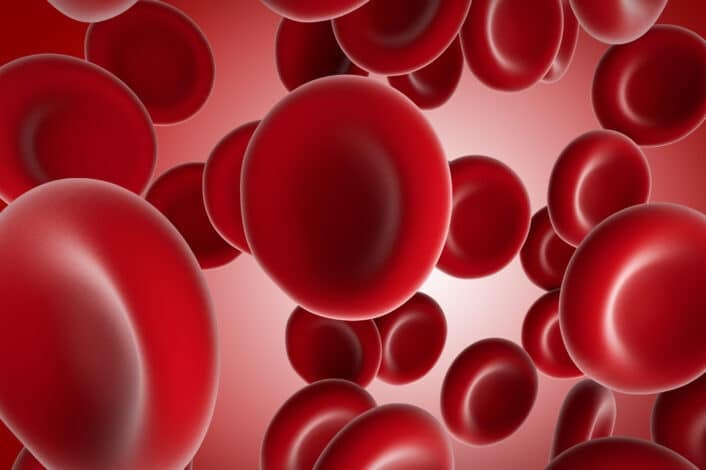

Disclaimer: This article is for informational purposes only and is not intended for diagnostic use. LifeDNA does not provide diagnostic reports on any traits discussed. Genetics is just one piece of the puzzle; please consult a healthcare professional for comprehensive guidance on any health condition.
Platelets, those tiny cell fragments in your blood, play a crucial role in clotting and healing wounds. When your platelet count is too low or too high, it can signal various health issues. But what determines your platelet count? Could your genetics affect something this fundamental?
Blood is more than just a red liquid; it’s a complex system full of fascinating components. Among these are platelets, tiny but mighty players in the body’s defense mechanism against bleeding. Platelets, also known as thrombocytes, are small, colorless cell fragments in the blood that are crucial for blood clotting and wound healing. Unlike red and white blood cells, human platelets do not have a nucleus. They are produced in the bone marrow from large cells called megakaryocytes, which release thousands of platelets into the bloodstream.
Platelets circulate in the blood and are always on standby to respond to blood vessel injuries. When a blood vessel is damaged, platelets rush to the site and adhere to the vessel’s lining. They release chemicals that activate other platelets and initiate the formation of a platelet plug, a temporary seal to prevent further bleeding.
Additionally, platelets release substances that interact with proteins in the blood plasma to form a more stable clot, a fibrin clot. Understanding platelet function and count is essential in diagnosing and managing many hematologic and cardiovascular diseases.
Platelet counts reveal critical information about a person’s blood health and potential underlying conditions. A platelet count measures the number of platelets, or thrombocytes, in a microliter of blood. These tiny, disc-shaped cells are vital for blood clotting and wound repair.
Blood samples for platelet counts are often analyzed using automated hematology analyzers. These machines provide quick and accurate results, which are essential for diagnosing and monitoring various medical conditions.
Monitoring platelet counts helps healthcare providers manage health risks and tailor treatments accordingly. Regular platelet count tests are crucial for patients with chronic illnesses, those undergoing certain treatments, or individuals with symptoms indicative of platelet disorders.
Testing for platelet count is a straightforward yet crucial procedure in medical diagnostics. The process usually begins with a complete blood count (CBC) test, which includes a platelet count as one of its components. A healthcare professional collects a blood sample, typically from a vein in the arm, using a sterile needle. The blood sample is then sent to a laboratory for analysis.
In the lab, automated hematology analyzers are commonly used to count platelets. These machines work by measuring the electrical impedance or light scattering properties of the blood cells. The results provide a platelet count, expressed as the number of platelets per microliter of blood. Normal platelet counts range from 150,000 to 450,000 platelets per microliter.
Platelet counts outside this range can indicate various medical conditions. Low platelet counts, or thrombocytopenia, can be caused by bone marrow disorders, autoimmune diseases, certain infections, or medications. Symptoms of low platelet counts include easy bruising, prolonged bleeding, and spontaneous bleeding from the gums or nose.
Conversely, high platelet counts, or thrombocytosis, can result from bone marrow disorders, inflammation, infection, or cancer. Elevated platelet levels increase the risk of abnormal blood clots, which can lead to strokes or heart attacks. Regular monitoring of platelet counts helps in the diagnosis and management of these conditions, guiding appropriate medical intervention.
The Janus Kinase 2 gene (JAK2) provides instructions for making a protein that regulates blood cell production in the bone marrow. Mutations in JAK2 can lead to myeloproliferative neoplasms (MPNs), where the bone marrow produces excessive blood cells. Common MPNs linked to JAK2 mutations include:
The JAK2 V617F mutation is the most studied, causing the JAK2 protein to be constantly active, leading to uncontrolled blood cell production. Other mutations in JAK2 can also contribute to these disorders, with tests available to detect various JAK2 mutations, including those in exon 12.
In essential thrombocythemia (ET), patients with CALR mutations exhibit a lower risk of thrombosis compared to those with JAK2V617F mutations. Research reveals that CALR-mutated platelets are less activated and adhere less to fibrinogen than control and JAK2-mutated platelets. Specifically, fewer CALR-mutated platelets fully spread on fibrinogen.
CALR mutations are linked to a more dispersed localization of the CALR protein and a unique interaction with TpoR, which affects platelet function. Despite higher platelet counts and increased immature platelets and platelet-leukocyte aggregates in ET patients overall, CALR mutations result in less activated platelets, which may explain the reduced thrombotic risk in these patients.
Platelet counts can be influenced by various factors beyond genetic predispositions. Understanding these factors provides a more comprehensive view of what affects platelet levels and how they can impact overall health.
Understanding these diverse factors is crucial for diagnosing and managing conditions that affect platelet levels, ensuring that patients receive appropriate care based on the underlying causes.
Platelets are vital for blood clotting, and their counts can reveal important health information. What do high and low platelet counts mean for your body?
High platelet counts, known as thrombocytosis, can be caused by various conditions. Primary thrombocytosis is due to bone marrow disorders like essential thrombocythemia or polycythemia vera, where the bone marrow produces too many platelets.
Secondary thrombocytosis is a reactive condition, often caused by inflammation, infection, cancer, or recent surgery. Elevated platelet levels can increase the risk of clot formation, leading to complications such as deep vein thrombosis, pulmonary embolism, heart attacks, or strokes.
Symptoms of high platelet counts may include headaches, dizziness, chest pain, and tingling in the hands and feet. In some cases, no symptoms are present, and thrombocytosis is detected incidentally during routine blood tests.
Low platelet counts, or thrombocytopenia, can result from several factors. Bone marrow disorders, such as leukemia or aplastic anemia, can reduce platelet production. Autoimmune diseases like immune thrombocytopenic purpura (ITP) cause the body to destroy its platelets.
Certain medications, including chemotherapy drugs and heparin, can also lead to thrombocytopenia. Additionally, viral infections such as dengue, hepatitis, and HIV can reduce platelet counts.
Symptoms of low platelet counts include easy bruising, prolonged bleeding from cuts, spontaneous bleeding from the gums or nose, and the appearance of petechiae, which are small red or purple spots on the skin caused by bleeding.
Managing high or low platelet counts involves addressing the underlying cause. For thrombocytosis, treatment may include medications to reduce platelet production or blood thinners to prevent clots.
Thrombocytopenia management might involve corticosteroids to suppress the immune system, medications to increase platelet production, or transfusions in severe cases. Regular monitoring and follow-up with healthcare providers are essential for managing platelet count abnormalities and minimizing the risk of complications. Understanding what high and low platelet counts mean can help individuals take proactive steps to maintain their health.
Maintaining a normal platelet count is essential for overall health, as platelets play a critical role in blood clotting and wound healing. Here are some scientifically-backed ways to maintain healthy platelet levels:
A nutritious diet rich in vitamins and minerals is crucial for maintaining normal platelet counts.
Excessive alcohol consumption can suppress bone marrow function, reducing platelet production. Smoking is associated with increased platelet activation and can elevate the risk of clot formation.
Adequate hydration supports overall cellular function, including platelet production. Aim to drink at least 8 glasses of water daily.
Engaging in moderate physical activity helps improve circulation and overall cardiovascular health, indirectly supporting healthy platelet levels. However, avoid excessive or high-risk activities that might lead to injury and bleeding.
Chronic stress can negatively impact the immune system and potentially affect platelet levels. Techniques such as meditation, yoga, and deep-breathing exercises can help manage stress effectively.
Exposure to certain chemicals, including pesticides and industrial solvents, can harm bone marrow function and reduce platelet production. Use protective gear and follow safety guidelines if you work in environments with such exposures.
Routine blood tests can monitor platelet levels and help detect any abnormalities early. Regular check-ups are especially important for individuals with a history of platelet disorders or other health conditions affecting platelet counts.
Some medications can affect platelet counts. Always inform your healthcare provider about all the medications and supplements you are taking. Avoid over-the-counter NSAIDs like aspirin and ibuprofen, which can impair platelet function, unless prescribed by a doctor.
Addressing health issues that can affect platelet counts is crucial. For instance, managing autoimmune diseases, liver conditions, and infections can help maintain normal platelet levels.
Certain natural substances are believed to support healthy platelet counts, though more research is needed.
Minimize the risk of injuries and avoid activities that may lead to cuts or bruises, especially if you already have a lower platelet count.
Maintaining normal platelet counts involves a combination of healthy lifestyle choices, proper nutrition, and regular medical care. By incorporating these strategies, individuals can support their body’s natural ability to produce and maintain adequate platelet levels, ensuring optimal blood clotting and overall health.
Discover the power of personalized wellness with LifeDNA’s Nutrition Report. This scientifically backed and comprehensive report delves into your unique genetic profile to help you understand your body’s specific needs. By analyzing more than 200 genetic traits, LifeDNA provides insights across seven main categories: Nutrition Report, Wellness Report, Sleep Report, Vitamins and Supplements Report, Fitness Report, Personality and Cognition Report, and Skincare. Premium insights like the Age-Related Report, Methylation Genes Report and Detoxification Genes Report are also available.
With LifeDNA’s Genetics Reports, you can uncover how your genetics influence your nutritional requirements, fitness potential, and overall well-being. Imagine knowing which vitamins and supplements your body needs the most, optimizing your sleep patterns based on genetic tendencies, or understanding your skin’s unique needs for healthier, more radiant skin.
Start your wellness journey with LifeDNA today. Empower yourself with the knowledge to make informed lifestyle choices and achieve your health goals. Avail of LifeDNA’s plans now and unlock the full potential of your genetic insights. Take the first step toward a healthier, more personalized approach to your well-being.
Experience the benefits of knowing your body like never before. Begin your journey with LifeDNA’s Nutrition Report and embrace a future of optimized health and wellness tailored just for you.


